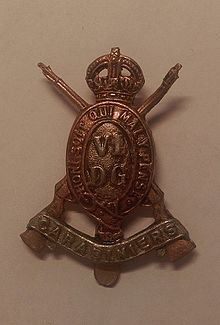Carabiniers (6th Dragoon Guards)
| Carabiniers (6th Dragoon Guards) | |
|---|---|
 Cap badge of the 6th Carabiniers | |
| Active | 1685-1922 |
| Country |
|
| Branch | Army |
| Type | Line Cavalry |
| Role | Cavalry |
| Size | One regiment |
| Motto(s) | Honi Soit Qui Mal Y Pense French (Evil upon him who evil thinks) |
| Commanders | |
| Notable commanders | Henry Leader |
The Carabiniers (6th Dragoon Guards) was a cavalry regiment of the British Army. It was formed in 1685 as the Lord Lumley's Regiment of Horse. It was renamed as His Majesty's 1st Regiment of Carabiniers in 1740, the 3rd Regiment of Horse (Carabiniers) in 1756 and the 6th Regiment of Dragoon Guards in 1788. After two centuries of service, including the First World War, the regiment was amalgamated with the 3rd Dragoon Guards (Prince of Wales's) to form the 3rd/6th Dragoon Guards in 1922.
History

The regiment was first raised by Richard Lumley, 1st Earl of Scarbrough as the Lord Lumley's Regiment of Horse in 1685, as part of the response to the Monmouth Rebellion by the regimenting of various independent troops, and was ranked as the 9th Regiment of Horse. Shortly thereafter, Lumley petitioned the Queen Dowager to permit labeling the regiment The Queen Dowager's Horse, which request was granted.[1] In 1690 it was re-ranked as the 8th Regiment of Horse and, after distinguishing itself during the Williamite War in Ireland and in Flanders during the Nine Years' War, it was renamed The King's Regiment of Carabineers in 1692.[1] The regiment was ranked as the 7th Horse in 1694[1] and it fought at the Battle of Blenheim in August 1704 and the Battle of Ramillies in May 1706 during the War of the Spanish Succession.[2]
The regiment was renamed the His Majesty's 1st Regiment of Carabiniers in 1740[1] and it took part in the response to the Jacobite rising in 1745.[2] It was the transferred to the Irish establishment in 1746 and re-ranked as the 3rd Horse.[1] It was next re-designated the 3rd Regiment of Horse (Carabiniers) in 1756 and then transferred back to the British establishment as the 6th Regiment of Dragoon Guards in 1788.[1] It saw action in Flanders again in 1793 during the French Revolutionary Wars.[2] It then became the 6th Regiment of Dragoon Guards (Carabineers) in 1826.[1] It saw action at the Siege of Sevastopol during the Crimean War and was deployed to Afghanistan in the late 1870s during the Second Anglo-Afghan War.[2] The regiment also took part in the relief of Kimberley in February 1900 during the Second Boer War.[3]
In 1906, the regiment took part in the parade at the Grand Durbar (the visit of the Prince and Princess of Wales to Bangalore).[2] It landed in France at the outbreak of the First World War as part of the 4th Cavalry Brigade in the 1st Cavalry Division on 16 August 1914 for service on the Western Front.[4] It took part in the Battle of Mons in August 1914, the First Battle of the Marne in September 1914, the First Battle of Ypres in October 1914 and the Second Battle of Ypres in April 1915 before going on to see further action at the Battle of the Somme in Autumn 1916, the Battle of Arras in April 1917 and the Battle of Cambrai in November 1917.[2]
In October 1922, the regiment was amalgamated with the 3rd Dragoon Guards (Prince of Wales's) to form the 3rd/6th Dragoon Guards.[1]
Battle honours

The regiment's battle honours were as follows:[1]
- Early Wars: Blenheim, Ramillies, Oudenarde, Malplaquet, Warburg, Willems, Sevastopol, Delhi 1857, Afghanistan 1879-80, Relief of Kimberley, Paardeberg, South Africa 1899-1902
- The Great War: Mons, Le Cateau, Retreat from Mons, Marne 1914, Aisne 1914, Messines 1914, Armentières 1914, Ypres 1915, St. Julien, Bellewaarde, Arras 1917 Scarpe 1917, Cambrai 1917 '18, Somme 1918, St. Quentin, Lys, Hazebrouck, Amiens, Bapaume 1918, Hindenburg Line, Canal du Nord, Selle, Sambre, Pursuit to Mons, France and Flanders 1914-18
Colonels
The regiment's colonels were as follows:[1]
1685 The Queen Dowager's Regiment of Horse
- 1685 Richard Lumley, 1st Earl of Scarbrough
- 1687 Sir John Talbot
- 1688 Sir George Hewett, 1st Viscount Hewett
- 1689 Richard Beverley
1692 The King's Regiment of Carabineers
- 1692 Hugh Wyndham
- 1706 Francis Palmes
- 1712 Leigh Backwell
- 1715 Richard Waring
- 1721 Richard Boyle, 2nd Viscount Shannon
- 1727 George MacCartney
- 1730 Henry Scott, 1st Earl of Deloraine
- 1731 Sir Robert Rich, 4th Baronet
- 1733 Charles Cathcart, 8th Lord Cathcart
1740 His Majesty's 1st Regiment of Carabiniers
- 1740 Phineas Bowles
- 1749 Hon. James Cholmondeley
- 1750 George Germain, 1st Viscount Sackville
1756 3rd Regiment of Horse (Carabiniers)
- 1757 Louis Dejean
- 1764 Edward Harvey
- 1775 Sir William Augustus Pitt
- 1780 Sir John Irwin
1788 6th Regiment of Dragoon Guards
- 1788 Henry Lawes Luttrell, 2nd Earl of Carhampton
- 1821 Hon. Robert Taylor
1826 6th Regiment of Dragoon Guards (Carabineers)
- 1839 Sir Thomas Hawker
- 1858 Sir Alexander Kennedy Clark-Kennedy
- 1860 Sir James Jackson
- 1868 Sir John Rowland Smyth
- 1873 Henry Richmond Jones
- 1880 George Calvert Clarke
- 1891 Charles Sawyer
- 1892 Sir Alexander James Hardy Elliot
- 1902 Sir John Fryer
- 1917 Henry Peregrine Leader
See also
References and notes
- ^ a b c d e f g h i j "6th Dragoon Guards (Carabiniers)". Regiments.org. Archived from the original on 4 February 2005. Retrieved 5 August 2016.
{{cite web}}: Unknown parameter|deadurl=ignored (|url-status=suggested) (help) - ^ a b c d e f "6th Dragoon Guards (Carabiniers)". National Army Museum. Retrieved 5 August 2016.
- ^ "6th Dragoon Guards". Anglo-Boer War. Retrieved 5 August 2016.
- ^ "The Dragoon Guards". The Long, Long Trail. Retrieved 5 August 2016.
